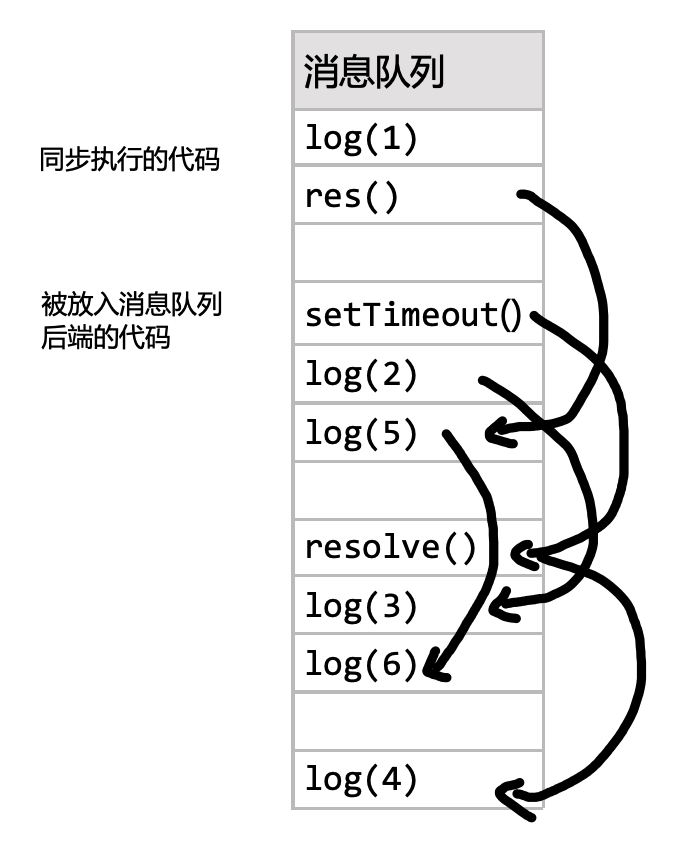Promise 必知必会
本文先讲讲现成的 Promise 对象怎么用,再讲怎么构造一个 Promise 对象。
怎么用
通过事件循环来异步执行的函数都有一个问题:如何优雅的调用函数,类似同步函数那样?
假设有一个createAudioFileAsync()函数,它接收一些config,然后异步的生成音频文件。
1 | createAudioFileAsync(); |
为了解决这个问题,可以给异步函数传两个回调函数,等生成音频成功或失败时调用。
1 | createAudioFileAsync( |
但这样就有个问题:想在createAudioFileAsync()成功后执行的代码,都要放到第一个回调函数里。回调函数本身没什么问题(只是缩进会多一层,作用域多一层),但如果后续代码里还有异步函数呢?再次用这种传入回调函数的方法,代码会横向扩展,陷入难以调试的回调地狱:
1 | async1((value) => { |
为了解决这个问题,可以让createAudioFileAsync()返回一个 Promise 对象,这样后续的回调就可以绑定在该 Promise 上。
用 Promise 重写这个函数后,可以用下面的方式调用它:
1 | createAudioFileAsync().then( |
这种写法下后续还需要调用异步函数怎么办?用 promise 重写每个异步函数(例如syncFunc = () => new Promise(/* 异步操作 */)),然后链式调用就好了:
1 | createAudioFileAsync() |
链式调用可以让代码更清爽,更可读和可调试。
约定
- 回调函数需要等本轮事件循环完成后才会调用(异步调用)。
1 | console.log(1); |
- 因为 1,即使 Promise 已经转到
fulfilled或者rejected状态,在这之后添加的then也会被异步调用。
1 | console.log(1); |
- 多次调用
then()可以绑定多个回调函数,它们会按顺序执行。
是什么
从代码的角度,是一个 JavaScript 对象。
从数学模型的角度,是一个有限状态机。
promise 是对象
其构造函数接受一个函数当参数,调用构造函数会立即执行这个函数
1 | console.log(1); |
这个函数叫做executor,接受 res、rej 两个函数作为参数。
如果executor内 res 被调动了,promise 转为 fulfilled 状态;
如果 rej 被调用了,就转为 rejected 状态
通常是在executor中执行一个异步函数,这个函数根据执行结果来决定调用 res 或者 rej
如果executor执行过程中抛出错误了,promise 直接转为 rejected 状态
1 | new Promise((res, rej) => { |
promise 还有一种 pending 状态,作为其初始状态。
promise 对象是一个状态机
从 pending 状态单项转换为 fulfilled 或者 rejected 状态。
只要发生了状态转变,就会调用 Promise.prototype.then 方法。
为什么有时候会调用 Promise.prototype.catch方法呢?其实catch是then的一种简写。
then(a, b)和then(a).catch(b)还是有区别的,区别在于a抛出的错误,只有后者才能catch住
传值
通常,两个异步函数要按顺序执行,肯定是后一个要用到前一个处理过的值。
再重复一下概念,「promise 构造函数」指new Promise()括号中传入的函数。「then 回调」指.then()括号中传入的函数。
从 promise 构造函数到 then 回调
通过在 promise 构造函数中给res或者rej传参,就可以给 then 回调函数传值了。res(1) ---> then((x) => x), x = 1then接受两个函数作为参数,状态转为fulfilled就调用第一个,转为rejected就调用第二个。常见的then只写第一个参数,catch常常写在一个 promise 调用链的最后,作为兜底的错误处理。catch(func)其实就是 then(null, func)——实际上,catch内部就是这么调用then的。
1 | new Promise((res, rej) => { |
从 then 回调到 then 回调(链式调用)
同样的,需要在 then 回调中设定返回值,传给下个 then。
首先区别一下「then 的返回值」、「then 回调的返回值」,前者指的是.then(),后者指的是括号内传入的函数的返回值。
then 的返回值为一个新的 Promise 对象,这使得.then().then().then()的语法成为可能。
如果 then 的回调函数:
- 想在 then 回调中执行异步函数,需要返回一个 promise:
- pending 状态,then 返回的 promise 状态也未定,两者状态会同步(注意,只是状态同步,两个 promise 依然不是同一个对象)。
- fulfilled 状态,执行后一个 then 回调。
- rejected 状态,执行后一个 catch 回调。
1 | new Promise((res) => res(1)) |
1 | new Promise((res) => res(1)) |
- 返回一个值,那么 then 的返回值会作为
fulfilled状态的回调函数(后一个 then)的参数值。return value等价于return Promise.resolve(value),返回了一个 fulfilled 的 promise 对象。 - 没有返回值,undefined 会作为下一个 then 参数值。then 返回的 promise 为fulfilled状态。
1 | new Promise((res) => res(1)) |
- 抛出错误,抛出的错误会作为拒绝状态的回调函数(后一个 catch)的参数值。then 返回的 promise 为rejected状态。
1 | new Promise((res) => res(1)) |
then 的参数不为函数
then 的第一个参数会在 promise 变为fulfilled时调用,如果这个参数不是函数,它会在内部被替换为x => x,也就是一个原样返回 promise 最终结果的函数。这种行为称为参数穿透。
1 | new Promise.resolve(3).then(4).then(console.log); |
Promise.prototype.finally
想要在 Promise 执行完毕后无论结果怎么样都做一些处理,可以用finally。
虽然与then类似,但用finally更适用于那些用then时两个参数有相同代码的情况,避免写冗余的代码。finally同样为 Promise 对象绑定一个事件回调,待 Promise 状态转换后调用,不论结果是fulfilled或者rejected,然后返回一个 Promise 对象。finally内必定发生参数穿透,回调本身的返回值不会作为 promise 链的一环,而是把上个 promise 的值原样传递下来。
由于不知道 Promise 状态,所以finally的回调是没有参数的。
1 | Promise.resolve(1) |
如果finally回调也返回一个 Promise,则等其状态转换后,finally返回的 Promise 才会改变状态,但回调返回的 Promise 状态不影响后续的调用链。后续的调用链依然由finally前的 Promise 决定。
1 | Promise.reject(2) |
一句话,用了finally一定会值穿透,前一个 Promise 的状态和值,会原封不动的传给finally返回的 Promise。
面试题分析
1 | new Promise((resolve) => setTimeout(resolve)).then(() => console.log(4)); |
注意,setTimeout函数本身会比其参数函数优先执行,也就是优先进入消息队列;同时setTimeout本身也是异步的,所以也得等消息队列没有其他消息才会执行这个函数。
解析:

写 Promise 的最佳实践
- 总是返回或者终止 Promise 链
- 一旦得到一个新的 Promise,返回它,而不是嵌套调用。
1 | // 错误示例,包含 3 个问题! |
1 | // 最佳实践 |
其他 API
Promise.race
接受一个可迭代对象(比如数组),返回一个 Promise 对象。
可迭代对象内任何一个 Promise 转移状态后,返回的 Promise 对象也转移到同一个状态。
当可迭代对象为空,Promise 对象始终保持pending
1 | Promise.race([ |
Promise.all
接受一个可迭代对象,返回一个 Promise 对象。
当可迭代对象内全部 Promise 都转为fulfilled,返回的 Promise 转为fulfilled;每个 Promise 的值都会传入新 promise 的参数数组
当可迭代对象内有一个 Promise 转为rejected,返回的 Promise 立刻转为rejected,不论另外的会怎样。
当可迭代对象为空,返回 Promise 对象会同步的直接转为fulfilled。
1 | Promise.all([ |
async await 语法糖
不得不说,为了解决异步操作,Promise 依然有额外的复杂性。
async 函数诞生于 ES2017,有人认为是异步操作的终极解决方案。看看从 promise().then() 的代码如何用 async 函数重写:
1 | const demo1 = async () => { |
抛开 async 和 await 关键字,写起来简直和同步函数一样!
不过底层机制依然是利用了 Promise,await关键字后边需要跟一个 Promise 对象,其返回值就是 Promise 构造函数里 resolve 传入的值。
async 函数本质上是 Generator 函数的语法糖,其中 Generator 函数是协程在 ES6 中的实现。它可以交出函数的执行权,即暂停执行,来实现像是同步写法那样的异步操作。
Promise 解决了多个异步函数同步调用造成的回调地狱问题;async 函数则让异步函数写起来更加优雅了。
用 async 函数重写 promise 链
假如 promise 链的一部分执行了如下代码
1 | const getProgressData = (url) => { |
用 async 函数重写:
1 | const getProgressData = async (url) => { |
注意 async 函数的返回值没有显式的被 promise 包裹,因为 async 函数会隐式地将它传递给 Promise.resolve,这样非原生 Promise 也能正常用了。
当 await 某个 Promise 时,函数暂停执行,直至该 Promise 产生结果,并且暂停并不会阻塞主线程,这涉及到协程的概念。
有关 async 函数、协程、Generator 函数,有空再聊。